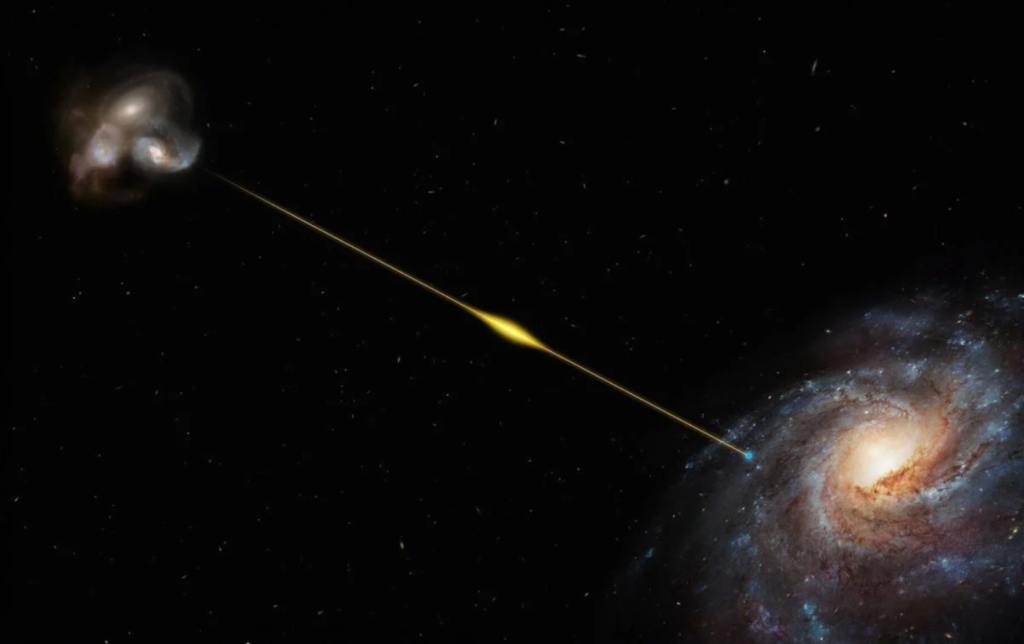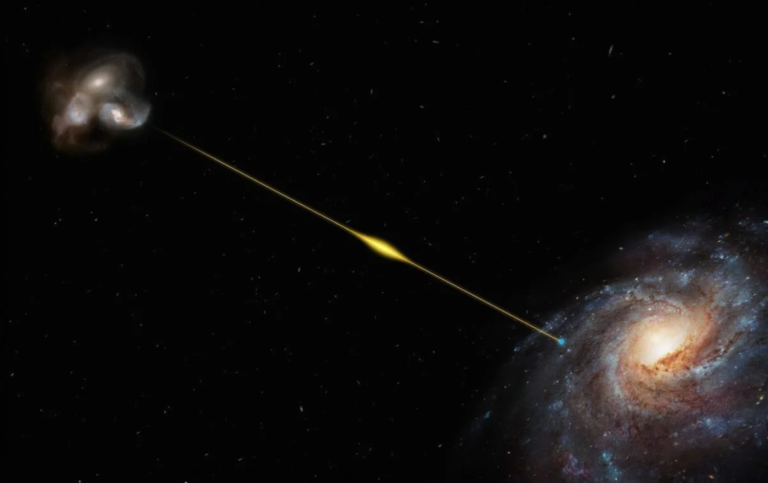Astronomers Identify Farthest Fast Radio Burst on Record
An international team has observed an incredibly brief outburst of cosmic radio waves, known as a “fast radio burst” (FRB), that stands as the most distant ever recorded. The European Southern Observatory’s (ESO) Very Large Telescope (VLT) determined the origin of this FRB, located in a galaxy so remote that its light journeyed for 8 billion years to reach us. This FRB also ranks among the most powerful ever witnessed, releasing in a fraction of a second the equivalent energy of our sun’s total emissions over 30 years.

The discovery of this burst, designated as FRB 20220610A, occurred in June of the previous year thanks to Australia’s ASKAP radio telescope, breaking the team’s previous distance record by 50 percent.
Stuart Ryder, an astronomer from Macquarie University in Australia and co-lead author of the study titled “A luminous fast radio burst that probes the Universe at redshift 1,” published in Science, explained, “Using ASKAP’s array of dishes, we precisely pinpointed the burst’s source. Subsequently, we employed ESO’s VLT in Chile to locate the source galaxy, revealing it to be older and more remote than any previous FRB source, likely situated within a small group of merging galaxies.”
This finding underscores the capacity of FRBs to gauge the ‘missing’ matter scattered between galaxies, offering a fresh approach to ‘weighing’ the universe.
Existing methods for estimating the universe’s mass yield conflicting results, challenging the conventional cosmological model. As Ryan Shannon, a professor at Swinburne University of Technology in Australia and co-lead of the study, noted, “If we tally up the amount of normal matter in the universe—atoms that constitute all matter—we find that over half of the expected matter is unaccounted for today.” He added, “We think this missing matter resides in the intergalactic void, but it might be so diffuse and hot that conventional techniques cannot detect it.”
“Fast radio bursts can sense this ionized material. Even in seemingly empty space, they can ‘detect’ all the electrons, allowing us to measure the substance existing between galaxies,” Shannon pointed out.
Discovering remote FRBs is instrumental in accurately gauging the universe’s missing matter, a concept demonstrated by the late Australian astronomer Jean-Pierre (J-P) Macquart in 2020. Ryder emphasized that “J-P revealed that the more distant a fast radio burst is, the more dispersed gas it reveals between galaxies, a principle now known as the Macquart relation. Some recent FRBs appeared to defy this relationship, but our measurements confirm that the Macquart relation remains valid up to half of the observable universe.”
Shannon emphasized, “While we still lack a definitive understanding of the origins of these massive energy bursts, our study verifies that fast radio bursts are frequent events in the cosmos, enabling us to detect matter residing between galaxies and gain a better comprehension of the universe’s structure.”
This achievement signifies the current limit of what telescopes can achieve. However, astronomers are poised to gain advanced tools to detect even more ancient and remote bursts, precisely pinpoint their source galaxies, and measure the universe’s elusive matter.
The international Square Kilometer Array Observatory is presently constructing two radio telescopes in South Africa and Australia, capable of identifying thousands of FRBs, including those too distant for current equipment to detect. The ESO’s Extremely Large Telescope, a 39-meter telescope under construction in the Chilean Atacama Desert, will be one of the few instruments capable of studying the source galaxies of bursts located even farther away than FRB 20220610A.
This article is republished from PhysORG under a Creative Commons license. Read the original article.
Do not forget to share your opinion with us to provide you with the best posts !




0 Comments